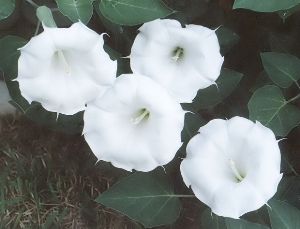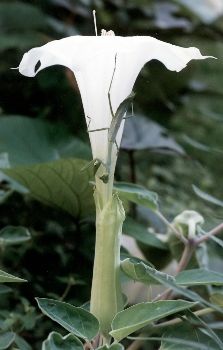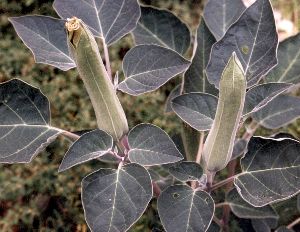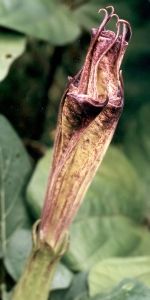Jimsonweed
by Valerie (June 27, 2000)
revised October 30, 2003
 Jimsonweed (Datura stramonium) is an enjoyable plant to grow. I think it is often said to be an annual, but all our plants have lived more than one year, simply dying back to the base when frozen, so they appear to be short-lived perennials in our area. I started the plants in several places in our gardens from some seeds. One plant was in a very hot, dry, well-drained area that got full afternoon and evening sun. A large maple tree growing to one side of it further increased the dryness by hogging all the water in the soil with its many shallow roots. This plant lived for several years, producing abundant flowers, but needing frequent watering to keep it from completely wilting. One year was particularly hot and dry and it finally died off at the end of summer and didn't come back in the spring. A couple of plants in semi-shade do moderately good, producing a few blossoms, but often losing a lot of leaves to insects. The one plant that did the best was about twenty feet away from the large one that died, but down a slight slope and in a slightly moister area. This plant lived about six years and got bigger every year, producing lots of flowers, especially during rainy periods. It was also protected by other plants growing right around it. One spring, it produced only a tiny shoot, which broke off and the plant died.
Jimsonweed (Datura stramonium) is an enjoyable plant to grow. I think it is often said to be an annual, but all our plants have lived more than one year, simply dying back to the base when frozen, so they appear to be short-lived perennials in our area. I started the plants in several places in our gardens from some seeds. One plant was in a very hot, dry, well-drained area that got full afternoon and evening sun. A large maple tree growing to one side of it further increased the dryness by hogging all the water in the soil with its many shallow roots. This plant lived for several years, producing abundant flowers, but needing frequent watering to keep it from completely wilting. One year was particularly hot and dry and it finally died off at the end of summer and didn't come back in the spring. A couple of plants in semi-shade do moderately good, producing a few blossoms, but often losing a lot of leaves to insects. The one plant that did the best was about twenty feet away from the large one that died, but down a slight slope and in a slightly moister area. This plant lived about six years and got bigger every year, producing lots of flowers, especially during rainy periods. It was also protected by other plants growing right around it. One spring, it produced only a tiny shoot, which broke off and the plant died.

Jimsonweed has a number of colloquial names, including moonflower, thorn-apple, mad apple, devil's trumpet, devil's apple, stinkwort, Jamestown weed and datura. It is a poisonous plant related to nightshade and tomatoes, and is well-known for its hallucinogenic properties. Its leaves are large, soft, and slightly fuzzy. The blossoms are huge: about five to six inches across, and open at night, wilting by noon the next day. The main pollinators are sphinx moths (also called hawk moths or hummingbird moths). The caterpillars of these moths (hornworms) also feed on the plants. A lot of other insects are attracted to the huge flowers and I've watched bees wiggle down into the long tube and practically be swallowed up by the size of it. Small spiders sometimes even stake out a blossom as if they are after really big game. Praying mantises are a little better proportioned to take advantage of the lure of such a large flower.
|



 A closely related plant, which we have grown occasionally, is the double purple moonflower (Datura metel or D. fatuosa). Like the jimsonweed, this plant has many common names: purple thorn apple, horn-of-plenty, downy thorn apple, Hindu thorn apple, hoary thorn apple, and several of the same names as jimsonweed. The purple moonflower shows considerable variety in its blossoms and they can be single, double or triple, depending on the strain grown. The purple moonflower is not as hardy as jimsonweed and ours only live for a year, generally exhibiting weak growth and only a few flowers. The flowers are unique, though, and it is a nice addition to the gardens.
A closely related plant, which we have grown occasionally, is the double purple moonflower (Datura metel or D. fatuosa). Like the jimsonweed, this plant has many common names: purple thorn apple, horn-of-plenty, downy thorn apple, Hindu thorn apple, hoary thorn apple, and several of the same names as jimsonweed. The purple moonflower shows considerable variety in its blossoms and they can be single, double or triple, depending on the strain grown. The purple moonflower is not as hardy as jimsonweed and ours only live for a year, generally exhibiting weak growth and only a few flowers. The flowers are unique, though, and it is a nice addition to the gardens.